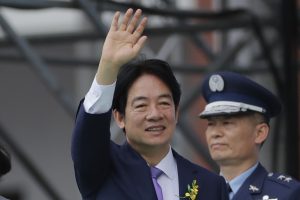The inaugural address of Taiwan’s new President Lai Ching-te late last month attracted international attention. The speech prompted a barrage of criticism from Beijing, which ramped up the pressure on Taiwan with military exercises. China likely paid special attention to the parts “the Republic of China Taiwan is a sovereign, independent nation in which sovereignty lies in the hands of the people” and “I think it is apparent to us all: We have a nation insofar as we have sovereignty. Right in the first chapter of our Constitution, it says that ‘The sovereignty of the Republic of China shall reside in the whole body of citizens,’ and that ‘Persons possessing the nationality of the Republic of China shall be citizens of the Republic of China.’ These two articles tell us clearly: The Republic of China and the People’s Republic of China are not subordinate to each other.”
These parts likewise piqued interest in Japan, with some pointing out that the arguments in Lai’s speech are similar to those of former President Chen Shui-bian’s “Two States Theory.” Other observers meanwhile highlighted Lai’s call for Taiwanese businesspeople who have expanded into China to return to Taiwan, emphasizing the need to further move away from economic dependence on China, a push that has been underway since the Tsai Ing-wen administration. At the same time, the view in Taiwan that Lai’s inaugural address has increased tensions in the Taiwan Strait was also expressed in Japan. Still, it has been pointed out that the overwhelming majority of Taiwanese voters are aware that Taiwan and the People’s Republic of China are separate and “not subordinate” to each other, which is why they are not fundamentally opposed to what Lai said; rather, the prevailing view is that Lai merely stated the “obvious” to Taiwanese voters.
One feature of the address is its use of the designations “Republic of China,” “Republic of China Taiwan,” and “Taiwan,” arguing that while China and Taiwan should respect each other, “we” living in Taiwan should come together as the owners of Taiwan. Another former president of Taiwan, Lee Teng-hui used the term “Republic of China in Taiwan” while Lai’s immediate predecessor Tsai Ing-wen used “Republic of China, Taiwan,” gradually lessening the distance between the Republic of China and Taiwan. With Lai Ching-te, though, we now see the use of “Taiwan” (without the Republic of China) rather than the “Republic of China Taiwan” appearing even in the inaugural address.
Lai’s speech can be distinguished from Tsai’s inaugural addresses in 2016 and 2020 in another important way. Lai made a number of references to the “past” and “history,” opening his speech by saying, “On this day in 1949, martial law went into effect in Taiwan, and Taiwan plunged into a dark era of authoritarian rule.” He then moved on to the 1996 presidential election and then to 2024. Lai cited three years, 1949, 1996, and 2024, as he explained Taiwan’s history. The ROC was established in 1912, and a portrait of the “Founder of the Nation,” Sun Yat-sen, still hangs in the Presidential Office Building. Yet while Lai made mention of martial law in 1949, he did not talk about the history of the Republic of China prior to that. At the same time, when pointing out the strategic position of Taiwan as the First Island Chain in a geopolitical sense, he said that “Even as early as 1921, Chiang Wei-shui (蔣渭水) said that ‘Taiwan is a frontline guardian of world peace.’ Now, in 2024, Taiwan’s role is even more significant.” Chiang is the person who founded the Taiwanese Cultural Association and the Taiwanese People’s Party during the Japanese occupation.
Then, toward the end of his speech, Lai talked about deciding to hold a “state banquet” in Tainan, welcoming guests from home and abroad on the occasion of his inauguration as president. He added: “Tainan, the city where 1624 marked Taiwan’s links to globalization. Now, as we stand here 400 years after that historical moment in Tainan, we in Taiwan must all demonstrate confidence and bravely set course for the new world, so that the world may embrace a new Taiwan.” The year 1624 was the year the Dutch East India Company built Fort Zeelandia (Anping Old Fort) in Tainan.
Lai’s inaugural address was a retrospective of Taiwan’s 400-year history; that is, Taiwanese history. In May 1996, Lee Teng-hui made a number of references to history in his presidential inaugural address. Yet what he spoke of was the 5,000-year history of the Chinese nation, trying to frame Taiwan with Sun Yat-sen’s Three Principles of the People. Some 28 years later, the view on history apparent in the presidential inaugural speech has become “Taiwanese history,” very much depicted as the history of the ROC. Indeed, many Taiwanese people likely feel quite comfortable with Lai’s perspective on history.
Nonetheless, the current Constitution of the Republic of China clearly states that the ROC was founded by Sun Yat-sen. It will be interesting to see how this constitutional view on history is reconciled with the perspective offered by Taiwan’s new president going forward.

































